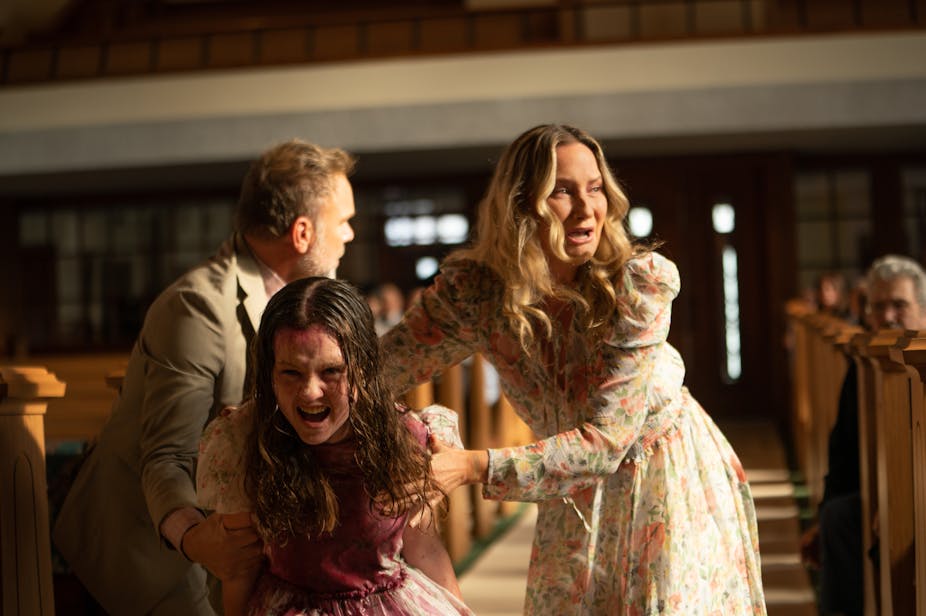Warning: this review contains some spoilers for The Exorcist: Believer.
Nobody who watches The Exorcist: Believer could claim that they didn’t get what they expected when they bought their ticket.
Two children experiment with the occult and inadvertently open the door to demonic forces that rapidly overwhelm them. They disappear for several days, and when they are eventually found, they display erratic behaviour that rapidly escalates into uncontrollable violence.
Their parents seek to discover the cause and reluctantly conclude that the answer lies in something supernatural and evil. They all struggle to reconcile what they are experiencing with their various worldviews, before eventually calling in the service of spiritual experts to perform an exorcism. As the events play out, there is a liberal splattering of gore, with the obligatory twisting heads and spewing of foul liquids.
The power of unity
It is striking that these elements mirror what was presented to audiences in the 1970s with the first Exorcist film. Even the central theme of “belief” is nothing new. A priest undergoing a crisis of faith is the central protagonist of William Blatty’s original Exorcist novel.
There are some aspects of The Exorcist: Believer that do reflect its 21st-century context, however. The team of exorcists who battle the demon are drawn from a variety of religious backgrounds and act together in a common cause. The message is that these believers have much more that unites than divides them.

Haitian spiritual practices and African-American root doctor traditions are presented as aligned with light, rather than darkness. This is extremely welcome. Given the amount of media that treats black and indigenous religion as sinister and even demonic, this positive portrayal is a commendable choice.
Equally, the decision to have Christian characters of various denominations stand alongside one another, as well as the traditional African American healer character, makes a powerful statement about community and togetherness.
But this homogenising approach is also problematic. The film asserts that exorcism exists in every culture and suggests that all people engaged in it are effectively doing the same thing. In reality, this is an oversimplification – with some potentially dangerous implications.
Read more: The Exorcist at 50: a terrifying film that symbolises the decline of America's faith and optimism
And the dangers
The term “exorcism” can be appropriately used to describe rituals from many global traditions, if it is defined as a practice that aims to free a person, place or object from a negative spiritual influence.
However, this very general category contains hugely diverse ideas. There is immense breadth in both underpinning belief systems (which span almost all forms of spirituality, including Roman Catholicism, Pentecostalism, Islam, Wicca and Hinduism) and also the means used to expel the malevolent spirit.
These distinctions matter. Especially when it comes to weighing up the balance between autonomy and protecting the person in real-life exorcisms.
Any legal framework that respects democratic and human rights supports freedom of belief and cultural diversity. But it must also protect those not fully able to advocate for themselves. This means decisions have to be made about when to permit exorcism rituals involving children and adults suffering from mental illness or impaired capacity.

When making these decisions, both the nature of the exorcism rite and the beliefs surrounding it are critical.
Some cultures see possession as an unlucky accident that can happen to anyone. Whereas others regard it as the result of either some deliberate act of wrongdoing or inherent flaw in the character – or even soul – of the supposedly possessed person.
Some faith traditions consider afflicted people dangerous, leading them to be shunned or even attacked. In such circumstances, cooperating with a proposed exorcism ritual may be a person’s only option for reintegration within their community.
Also, some traditions believe that an evil entity is capable of hijacking a human body, suppressing the will of the host. In these circumstances, any resistance to the exorcism may be understood as coming from the spirit, rather than the person, and therefore ignored.
On the other hand, if the victim of possession is thought to retain some residual will, then any reluctance to participate in exorcism may be treated as evidence of a desire to choose evil.
It is also important to appreciate that modes of exorcism vary enormously – from quietly spoken prayers to violent assaults. Dangerous or abusive practices may also be employed. People may be encouraged – or forced – to ingest substances that are either harmful or risky because of the dose or manner of administration.
There have been exorcism-related deaths caused by salt poisoning, dry-drowning from water and even a near-fatal dose of intravenous drugs.
Taking all of this into account, conveying the message that exorcism is an essentially positive and universal practice shared by many cultures, is potentially dangerous.

Of course, cinema-goers are capable of distinguishing between fact and fiction and nobody would suggest that the Exorcist films should be treated as documentaries. But pop culture does influence people’s perceptions.
Public authorities do not always fully understand the beliefs and practices of minority groups, and this can cause problems. They may incorrectly perceive a situation to be risky and intervene when it’s unnecessary. Alternatively, a vulnerable person may be left without help because police or social workers misguidedly construe harmful practices as acceptable due to the cultural context.
These kinds of mistakes have contributed to preventable exorcism-related deaths, including those of children. The Excorcist: Believer’s treatment of exorcism as a simple and benign phenomenon spanning cultural and religious divides isn’t accurate, or even desirable – even in the context of a horror film.

Looking for something good? Cut through the noise with a carefully curated selection of the latest releases, live events and exhibitions, straight to your inbox every fortnight, on Fridays. Sign up here.

